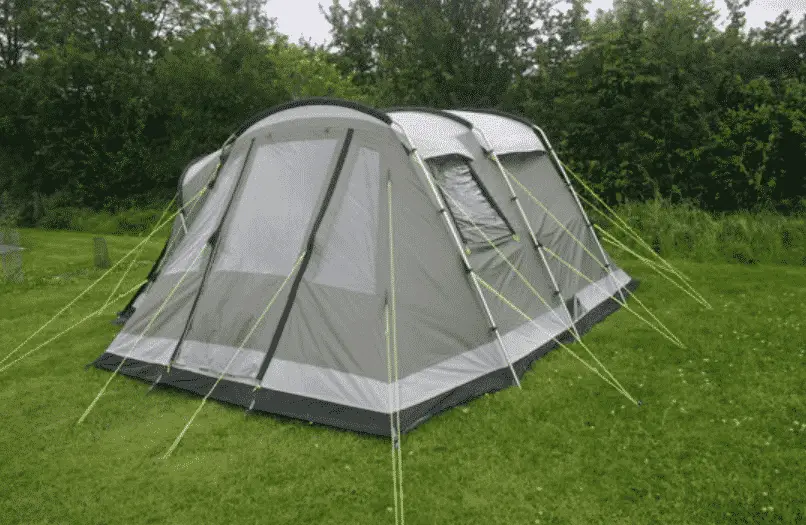Should your guy lines be loose, flexible, or tight? That’s a very important question to ask when switching over to a non-freestanding tent. It doesn’t sound like much, but a slight difference in angle or guy line pressure could result in your tent walls flailing in the wind. How tight should guy lines be?
Your guy lines should feel fairly tight to the touch. The key is tightening down your guy lines until your tent stops sagging and well before they stress your tent side walls. Tents are usually reinforced at the guy line points so overtightening guy lines won’t damage the tent, but it can twist the tent walls causing structural issues.
It can be hard to perfect your pitch setup when transitioning away from freestanding tents. In the rest of this post I’ll explain how to figure out guy line tension, go over using guy lines, and teach you how to perfect your guy line setup. It isn’t all that hard! So you should be able to get things right after practicing a handful of times.
How Tight Should Guy Lines Be?
Let’s start off by explaining the purpose of guy lines. Most people think that the guy lines are used for preventing a tent from flying away in the wind. That’s part of the reason we use guy lines, but wind is rarely strong enough to blow a tent away.
The main purpose of a guy line is to provide structural integrity to a non-freestanding tent. With a freestanding tent you have tent poles to completely support the structure. Non-freestanding tents shed weight by eliminating unnecessary tent poles and use guy lines to provide structure to the remaining poles. If you mess up the guy line tension it can seriously impact the structural integrity of your tent.
I also recommend choosing bright guy lines so you can see them in the dark and won’t trip on them. This won’t completely eliminate the tripping hazard, but it should help some. I’ve been camping for decades and still manage to trip on my lines stumbling around in the dark.
Hot To Tighten Tent Guy Lines
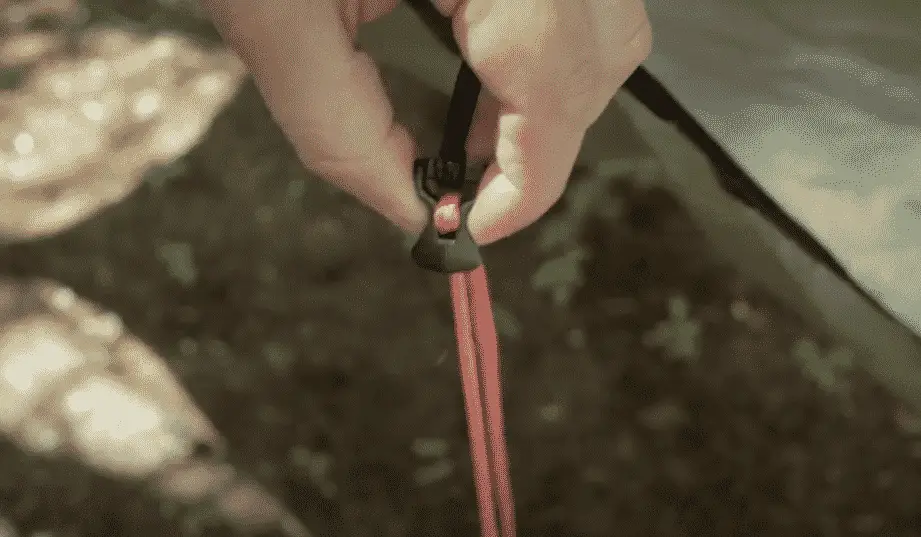
Obviously, you can’t have loose guy lines, because it won’t provide enough support, but how tight should guy lines be? The simple answer is tight, but not over-tensioned. Over-tensioning your guy lines will put too much pressure on your tent seams and sidewalls.
Tighten your guy lines until your tent stops sagging and before it distorts the shape of your tent’s sidewalls. A properly set up tent won’t have twists or turns in the sidewall fabric. It should look like a straight flat sheet of fabric.
If you notice ripples that means your guy lines are loose, overtightened, or you messed up the guy line angle. I’ll explain angling your guy lines below, so make sure you scroll all the way to the bottom if you’re having guy line issues. Here’s how to tighten tent guy lines to prevent flapping and improve the structural integrity of your tent.
- Attach The Guy Line To Your Tent: Notice the reinforced loops on each of your tents seams, usually at the corners. This is where you will be attaching your guy lines. Freestanding tents usually have loops attached to drive in stakes, but you’ll have to run real guy lines off non-freestanding tents. Run your guy lines through each attachment loop and tie them down. I recommend a clove hitch know which tightens with tension, but any knot will work.
- Follow The Tents Lines: Look at the lines on your tent and follow the seams at each attachment point. You want to run your guy lines 2-3 feet out from each of these attachment points in a straight line.
- Stake Down Your Guy Lines: After you’ve figured out where you need to run the lines it’s time to stake down your guy lines. I recommend purchasing lightweight heavy duty stakes if you’re backpacking or dealing with hard/rocky ground. I’ve been using the MSR Groundhog Stakes (.35oz each) for years and I really like them. They’re lightweight, extremely durable, and provide good holding power in most soil types(except sand). Push the stakes into the ground or drive them in at a 45° angle towards the tent using a rock or tent stake mallet.
- Tension The Guy Lines: You can either tension up your lines with knots or use a line tensioner to make it easier. I like the Gear Aid Line Tensioners (pictured above), but they all work the same. Tighten up your guy lines until your tents side walls smooth out into a flat surface. If the walls start to bend or crease that usually means there’s too much tension or you need to adjust the guy line angle or bring the tent stakes in. Stakes should be 2-3ft away from your tent and follow the lines in your tent seams.
Replace Your Tent Stakes For Better Support
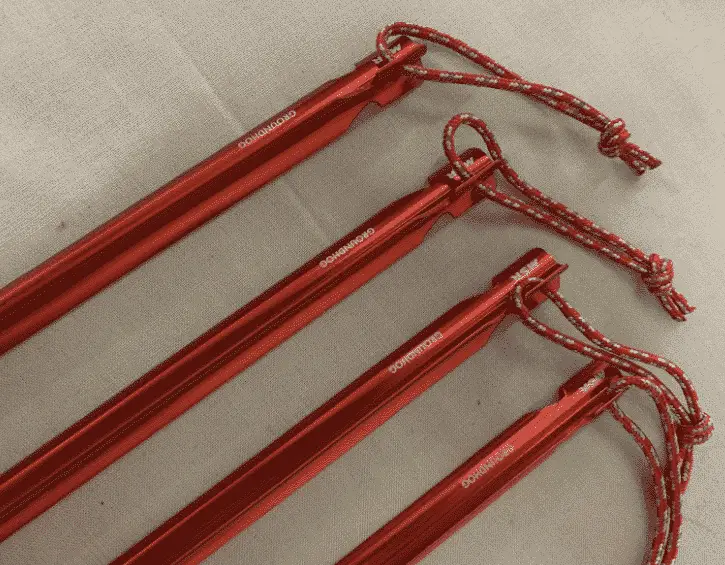
This is the perfect time to mention that you should probably get rid of the stakes that came with your tent. All tents come with stakes, but they usually have 9″ steel shepherd hooks that weigh over a pound(for a set). Expensive tents may come with lightweight aluminum shepherd hooks, but they bend easily and only have 3-4 pounds of holding power.
These tent stakes are better than nothing, but there are better options available. I recommend going with a Y or V Style tnet stake. They use lightweight aluminum and the design provides additional holding power.
MSR Groundhog tent stakes use a Y-Stake design and are usually considered the best tent stakes money can buy. Plus they’re reasonably priced! A set of 6 weighs just over 2oz, they have 15-20lbs of holding power in most soil types, and almost impossible to snap or bend.
Overtightening Your Guy Lines Can Damage Your Tent
Overtightening your guy lines rarely affects the structural integrity of your tent, but it can damage the seams and stitching on your tent. The only time you could run into structural issues is if you’ve messed up guy line angles. Not following the lines of your tent can throw off the balance of your tent poles, which could lead to bent or snapped poles.
Overtightened guy lines will also pull at the seams and stitching on your tent. This will rarely lead to a catastrophic seam tear, but it will slowly pull the seams apart leading to waterproofing issues. If you can see a hole in the seam you may have to sew it back together, but you can usually repair leaking tent seams by Applying Gear aid Seam Grip.
Loose Guy Lines Lead To Tents Flapping In The Wind
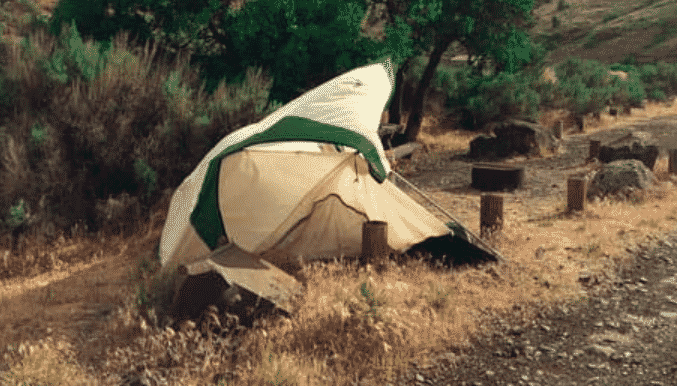
You will definitely know if your guy lines aren’t tight enough. Every time the wind blows your tents sidewalls will flap around. The walls probably won’t collapse, but it will wake you up and drive you absolutely crazy until they’re tightened.
Tent poles will usually hold in light wind, but the walls will push in taking up your living space. Moving your sleeping bag/pad a few feet into the tent is a temporary fix, but it’s always better to take the time to tighten up your lines.
It will take a strong gust of wind for you to run into structural issues with loose or poorly angled guy lines. There’s more of a chance of bending/snapping your tent poles which can cause a catastrophic collapse of a non-freestanding tent.
Most tents are only rated for 17 mph winds or less so you can have issues with even a perfectly pitched tent. That’s why I always carry a lightweight tent pole repair kit to temporarily deal with bent and damaged tent poles.
My Coghlan Tent Pole Repair Kit weighs just over an ounce and has everything you need to repair a bent tent pole or snapped shock cord. Just straighten out your bent pole by hand, slide the pole repair sleeve over the bent section, and tape up it on. You’ll want to replace the pole with a replacement aluminum or fiberglass pole once you get home.
Do All Tents Have Guy Lines!
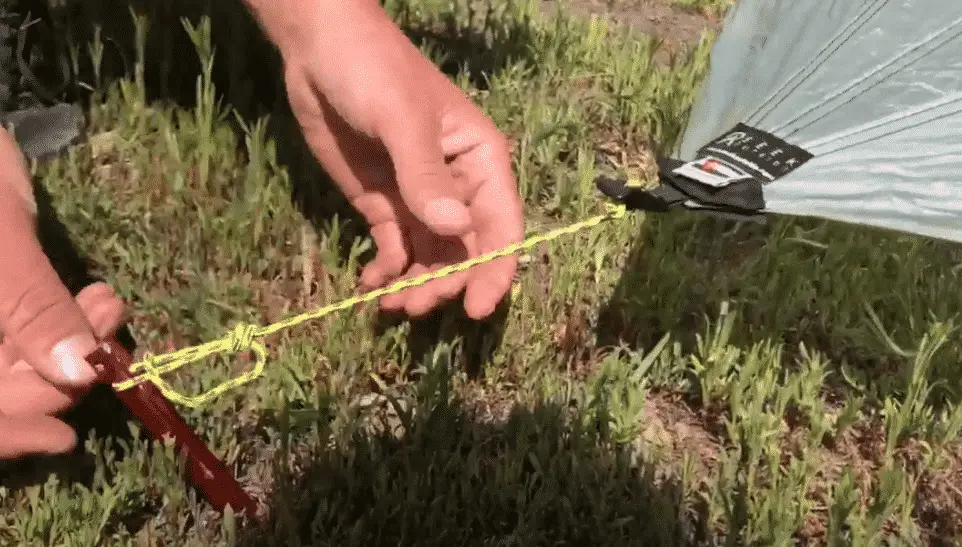
Freestanding tents use tent poles for structure so they don’t need guy lines for the main structure of the tent. They will have short guy lines (pictured above) on each corner of the tent and longer lines to support the rain fly and vestibule.
With a non-freestanding tent you will always have guy lines at each corner seam on the tent. Non-freestanding tents remove all the unnecessary poles to reduce trail weight. This slightly complicates tent setup, but you get close to a 50% reduction in trail weight.
The weight difference can be drastic when switching over to an aluminum pole non-freestanding tent. A cheap fiberglass pole freestanding tent weighs 7-10+ pounds and an aluminum pole non-freestanding tent usually weighs in the 1-3 pound range. There are a few lightweight freestanding tents, but those are prohibitively expensive.
How To Angle Tent Guy Lines
Angling your tent guy lines is a serious problem for beginners. Getting the angle wrong will have a serious effect on your tents structural integrity. You won’t be able to get the right guy line tension and you’ll end up with twisted sidewalls that flap in the wind.
Following the lines on your tent walls is the key to perfecting your guy line angles. You need to follow the lines on the corners of your tent walls and tension the guy lines in a straight line from each corner seam on your tent. It’s fairly simple once you learn the right technique.
Look at the corner seams on your tent and follow those lines. Pull your guy lines out a few feet away from the tent and start tensioning the guy lines. The tent walls should slowly start to flatten out until they look tight and perfectly flat.
That’s when you need to stop! If you keep going it will twist the sidewalls and put unnecessary stress on the tent seams. This won’t be a serious problem with a well built tent, but it can pull on the stitching and bend tent poles with cheap tents.
